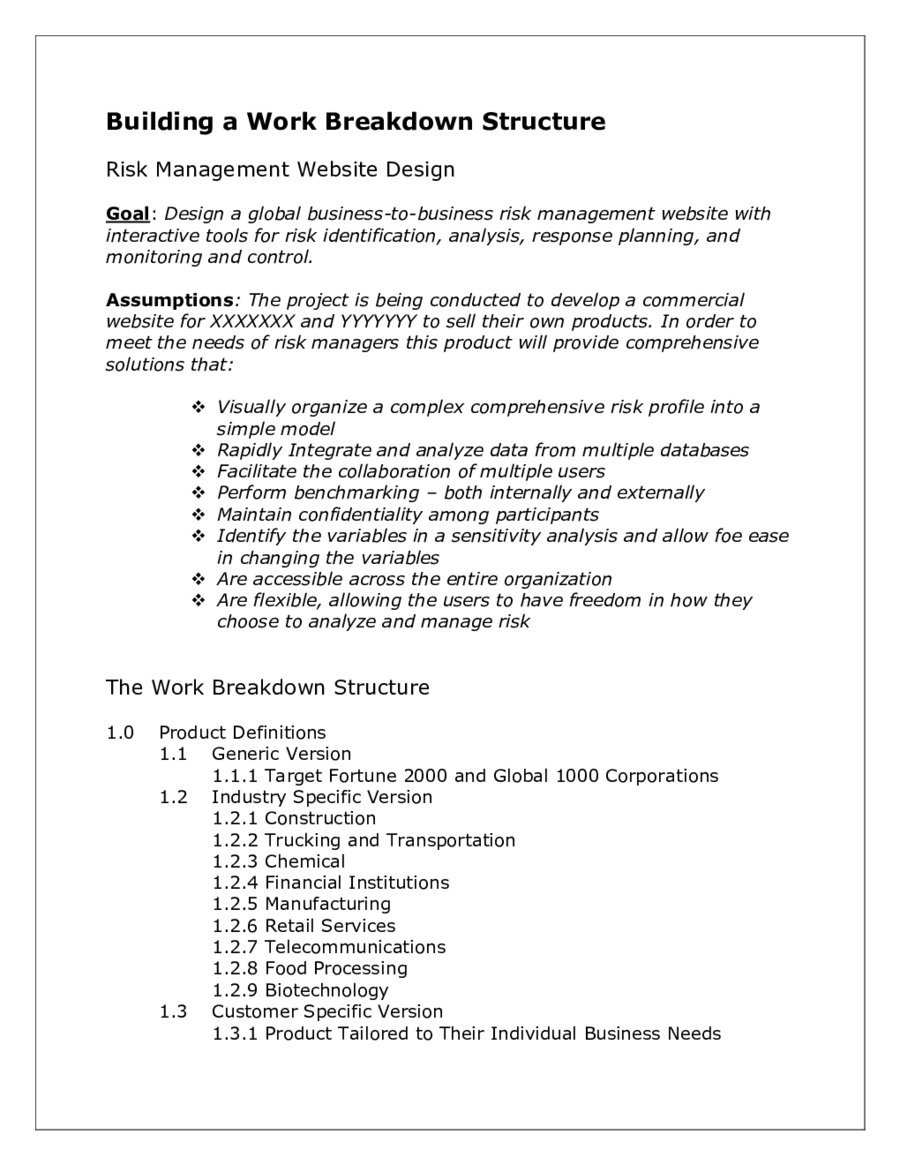Fillable Printable Project Work Breakdown Structure Template
Fillable Printable Project Work Breakdown Structure Template

Project Work Breakdown Structure Template

Building a Work Breakdown Structure
Risk Management Website Design
Goal: Design a global business-to-business risk management website with
interactive tools for risk identification, analysis, response planning, and
monitoring and control.
Assumptions: The project is being conducted to develop a commercial
website for XXXXXXX and YYYYYYY to sell their own products. In order to
meet the needs of risk managers this product will provide comprehensive
solutions that:
Visually organize a complex comprehensive risk profile into a
simple model
Rapidly Integrate and analyze data from multiple databases
Facilitate the collaboration of multiple users
Perform benchmarking – both internally and externally
Maintain confidentiality among participants
Identify the variables in a sensitivity analysis and allow foe ease
in changing the variables
Are accessible across the entire organization
Are flexible, allowing the users to have freedom in how they
choose to analyze and manage risk
The Work Breakdown Structure
1.0 Product Definitions
1.1 Generic Version
1.1.1 Target Fortune 2000 and Global 1000 Corporations
1.2 Industry Specific Version
1.2.1 Construction
1.2.2 Trucking and Transportation
1.2.3 Chemical
1.2.4 Financial Institutions
1.2.5 Manufacturing
1.2.6 Retail Services
1.2.7 Telecommunications
1.2.8 Food Processing
1.2.9 Biotechnology
1.3 Customer Specific Version
1.3.1 Product Tailored to Their Individual Business Needs

2.0 Product Specifications
2.1 Risk Management Approach
2.1.1 Risk Identification
2.1.1.1 Risk Review
2.1.1.2 Research Risks
2.1.1.3 Engage Risk Professionals
2.1.2 Risk Assessment
2.1.2.1 Identify Risk Variables
2.1.2.1.1 Measurement Methodologies
2.1.2.1.2 Data Sources
2.1.2.2 Obtain Data
2.1.2.3 Measure Risks
2.1.2.4 Build Risk Strategy Framework
2.1.2.5 Communicate Assessment
2.1.3 Risk Strategy
2.1.3.1 Define Corporate Risk Strategy
2.1.3.1.1 Determine Corporate Risk Tolerance
2.1.3.2 Define Individual Risk Strategies
2.1.4 Risk Solutions
2.1.4.1 Review Potential Solutions
2.1.4.2 Review Vendor Solutions
2.1.4.3 Select Vendor and Implement
2.2 Risk Management Tools
2.2.1 Survey Tool
2.2.1.1 Internal Surveys
2.2.2 Enterprise Risk Management Tool
2.2.2.1 Explicit Knowledge of the 180 Risks in the ERM
Taxonomy
2.2.3 Exposure Tracking Tool
2.2.3.1 Apply for New Insurance Coverage
2.2.3.2 Renew Insurance Coverage
2.2.3.3 Audit Insurance Coverage
2.2.4 Risk Impact Tables
2.2.4.1 Priority of Impact
2.2.4.1.1 Primary
2.2.4.1.2 Secondary
2.2.4.2 Nature of Impact
2.2.4.2.1 Cash Losses
2.2.4.2.2 Accounting Losses
2.2.4.3 Impact Duration
2.2.4.3.1 Long-term > 1 year
2.2.4.3.2 Short-term < 1 year
2.2.4.4 Impact Type
2.2.4.4.1 Direct

2.2.4.4.2 Indirect
2.2.4.5 Risk Type
2.2.4.5.1 Pecuniary
2.2.4.5.2 Non-pecuniary
2.2.5 Risk Impact Tool
2.2.5.1 Covariance Relationships Among Risks
2.2.6 Financial Risk Assessment Tool
2.2.6.1 Revenues
2.2.6.2 Cost of Goods Sold
2.2.6.3 Operating Expenses
2.2.6.4 Other Expenses
2.2.7 Risk Financing Ledger Tool
2.2.7.1 Insurance Cost vs. Transactional Budget
2.2.7.1.1 Expense and Cash Flow Basis
2.2.8 Pro-Forma Financial Assessment Tool
2.2.9 Statistical Tool Kit
2.2.10 Risk Strategy Tool
2.2.11 Risk Financing Advisor Tool
2.2.11.1 Recommends Various Risk Financing Options
2.3 Risk Management Communities
2.3.1 User Community Directory
2.3.2 Yellow Pages
2.3.3 Instant Chat Function
2.3.4 Search Capabilities
2.3.5 Chat Room
2.3.6 Job Postings
2.4 Heuristic Data and Information
2.4.1 Threaded Discussion Database
2.4.2 Survey Tool Database
2.4.3 Library Archive
2.4.4 Emerging Archive
2.4.5 Current Journals
2.4.6 User Library
2.5 Empirical Data and Information
2.5.1 Insurance Service Office Data
2.5.2 National Council on Compensation Insurance Data
2.5.3 Independent Bureau Data
2.5.4 Rating Agency Data
2.5.5 Company Specific Databases
3.0 Product Technology
3.1 Open Environment – No barriers
3.2 No proprietary or Exclusive Technologies
3.3 Rely on INTERNET Based technologies
3.4 Utilize an ANX Managed Network

3.5 Be Created Using XML
4.0 Product Content
4.1 Risk Description
4.2 Effect on Your Organization
4.3 Impact on Your Organization
4.4 Root Cause or Source of Origin in Your Organization
4.5 Warning Signs, Alerts or Indicators Your Organization is
Susceptible to This Risk
4.6 Risk Metrics and Analytical Tools
4.7 Strategies For Monitoring and Controlling Risk
4.8 Knowledge Contacts
4.8.1 Internal
4.8.2 External
4.9 Lessons Learned
4.10 Best Practices
4.11 Library or Media Resources
5.0 Web Design
5.1 Web Design Methodologies
5.1.1 Evaluate Available Web Design Methodologies
5.1.2 Select Web Design Methodology
5.2 Web Designer
5.2.1 Identify Characteristics and Job Description for Web
Designer
5.2.2 Solicitation Planning
5.2.3 Solicitation of Web Designer
5.2.4 Hire Web Designer
5.2.5 Educate Web Designer
5.2.6 Contract Administration
5.2.7 Contract Close-out
5.3 Web Site Layout and Navigational Design
5.3.1 Consult Web Design Expert
5.3.2 Decide on Web Site Layout and Navigational Design
5.4 Web Site Programs
5.4.1 Validate Web Design in Conformance to Internal Business
Processes
5.4.2 Validate Web Site in Conformance With External
Requirements
5.4.3 Approve Solution
6.0 Hardware Selection
6.1 Determine Sizing
6.2 Specify Hardware Architecture
6.3 Buy Hardware
6.4 Install hardware
6.5 Test Hardware

7.0 Software
7.1 Obtain Programmers
7.1.1 Educate Programmers to Project & Product Requirements
7.2 Design Programs
7.3 Conduct Program Peer Review
7.4 Prototype Programs
7.5 Order Entry
7.5.1 Code Order Entry
7.5.2 Test Order Entry
7.6 Order Fulfillment
7.6.1 Code Order Fulfillment
7.6.2 Test Order Fulfillment
7.7 Acknowledgement
7.7.1 Code Acknowledgement
7.7.2 Test Acknowledgement
7.8 Invoicing
7.9 Database
7.9.1 Database Design
7.9.2 Build Database
7.9.3 Cleanse Data
7.9.4 Load Database
7.10 Test SQL
8.0 Communications
8.1 Choose INTERNET Service Provider
8.2 Choose Telecom Vendor
8.3 Define Network Environment
8.4 Select Communication Method to Infrastructure Vendor
8.5 Firewall and Encryption Security
9.0 Integration
9.1 Install Software Application on Hardware
9.2 Middleware Application Test
9.3 External Network Test
9.4 Performance System Test
10.0 Logistics
10.1 Order Processing Link
10.1.1 Invoice Link
10.1.2 Replenish/Forecast Link
10.2 Shipping Link
10.3 Customer Support Link
10.4 Link to Credit Authorization



